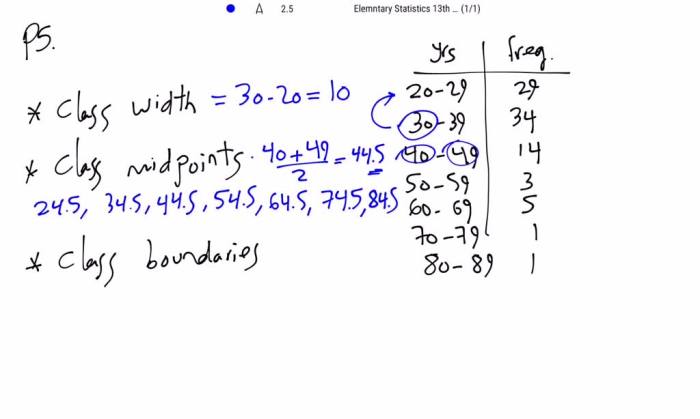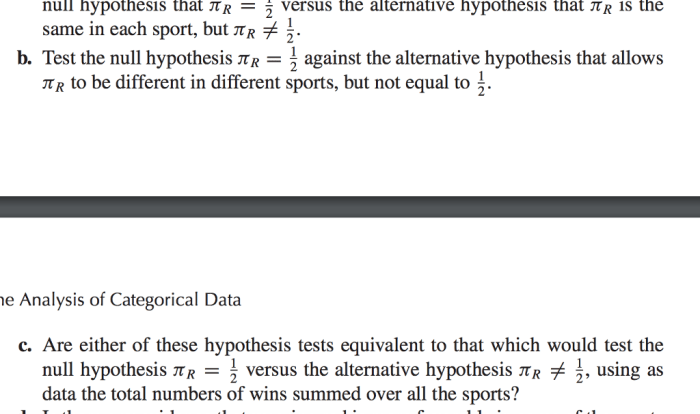Identify the lower class limits upper class limits class width – Identifying the lower class limits, upper class limits, and class width is a crucial step in data analysis, enabling researchers to classify and analyze data effectively. By understanding these concepts and their significance, analysts can gain valuable insights into data distribution, trends, and patterns.
This comprehensive guide explores the methods for identifying class limits, the factors influencing their choice, and the practical applications of class limits in various fields. It also provides visual representations and real-world examples to enhance understanding and demonstrate the utility of class limits in data analysis.
1. Introduction

In data analysis, class limits are essential concepts that define the boundaries of data classes. Lower class limits refer to the lowest value included in a class, while upper class limits refer to the highest value included. Class width represents the difference between the upper and lower class limits.
These concepts play a crucial role in data classification and analysis, as they determine the number and range of classes used to represent the data.
2. Methods for Identifying Class Limits

Various methods exist for identifying class limits:
Equal-Width Classes
- Divide the range of data into equal intervals.
- Advantages: Simple and easy to implement.
- Disadvantages: May not be suitable for skewed data or data with outliers.
Equal-Frequency Classes
- Divide the data into classes containing an equal number of observations.
- Advantages: Ensures equal representation of all data points.
- Disadvantages: Can result in uneven class widths and may not be suitable for skewed data.
Sturges’ Rule
- k = 1 + 3.3 log 10(n)
- where k is the number of classes and n is the number of observations.
- Advantages: Provides a reasonable number of classes for most data distributions.
- Disadvantages: May not be suitable for very large or very small datasets.
Scott’s Normal Reference Rule, Identify the lower class limits upper class limits class width
- h = 3.49 s n -1/3
- where h is the class width, s is the sample standard deviation, and n is the number of observations.
- Advantages: Suitable for unimodal data distributions with a normal or near-normal shape.
- Disadvantages: May not be appropriate for skewed or multimodal data.
3. Factors Influencing Class Limits

The choice of class limits is influenced by several factors:
- Data distribution:Skewness or multimodal data may require unequal class widths.
- Research objectives:The purpose of the analysis should guide the selection of class limits.
- Data analysis techniques:Different statistical methods may have specific requirements for class limits.
Trade-offs:
- Large number of classes:More detail, but may obscure patterns.
- Small number of classes:Less detail, but may reveal broader trends.
4. Visual Representation of Class Limits

Visual representations of class limits using histograms or frequency distributions help identify patterns and outliers:
Histograms
- Display the frequency of data points within each class.
- Provide a visual representation of the distribution of data.
Frequency Distributions
- Similar to histograms, but use lines to connect the frequency of data points.
- Can reveal patterns and trends in the data more clearly.
5. Applications of Class Limits: Identify The Lower Class Limits Upper Class Limits Class Width
Class limits have wide-ranging applications:
- Market research:Classifying consumers based on income, age, or spending habits.
- Finance:Analyzing stock prices, returns, or risk levels.
- Social sciences:Studying social mobility, education levels, or health outcomes.
Benefits:
- Understanding data distribution:Identifying patterns, trends, and outliers.
- Identifying trends:Monitoring changes in data over time.
- Making informed decisions:Drawing conclusions and taking action based on data analysis.
Clarifying Questions
What is the purpose of identifying class limits?
Identifying class limits allows researchers to divide a continuous data set into manageable and meaningful intervals, facilitating data analysis and interpretation.
How do I determine the appropriate class width?
The choice of class width depends on factors such as data distribution, research objectives, and the desired level of detail. A larger class width provides a broader overview, while a smaller class width offers more granularity.
What are the advantages of using class limits?
Class limits simplify data analysis by reducing the number of data points and making it easier to identify patterns and trends. They also facilitate the creation of histograms and other visual representations, which can further enhance data interpretation.
